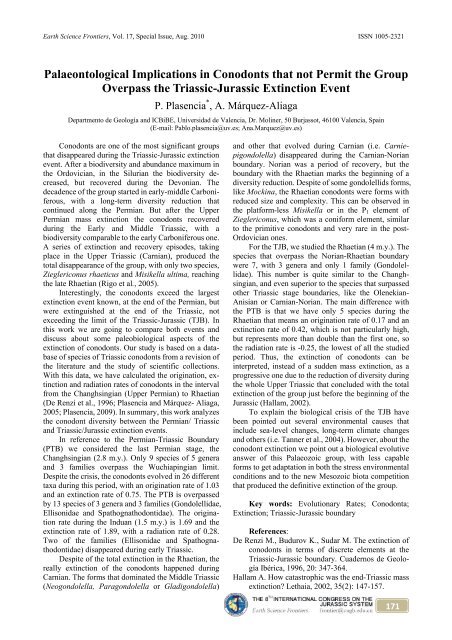in Jurassic and Cretaceous Stratigraphy
in Jurassic and Cretaceous Stratigraphy
in Jurassic and Cretaceous Stratigraphy
Create successful ePaper yourself
Turn your PDF publications into a flip-book with our unique Google optimized e-Paper software.
Earth Science Frontiers, Vol. 17, Special Issue, Aug. 2010 ISSN 1005-2321<br />
Palaeontological Implications <strong>in</strong> Conodonts that not Permit the Group<br />
Overpass the Triassic-<strong>Jurassic</strong> Ext<strong>in</strong>ction Event<br />
P. Plasencia * , A. Márquez-Aliaga<br />
Departmento de Geología <strong>and</strong> ICBiBE, Universidad de Valencia, Dr. Mol<strong>in</strong>er, 50 Burjassot, 46100 Valencia, Spa<strong>in</strong><br />
(E-mail: Pablo.plasencia@uv.es; Ana.Marquez@uv.es)<br />
Conodonts are one of the most significant groups<br />
that disappeared dur<strong>in</strong>g the Triassic-<strong>Jurassic</strong> ext<strong>in</strong>ction<br />
event. After a biodiversity <strong>and</strong> abundance maximum <strong>in</strong><br />
the Ordovician, <strong>in</strong> the Silurian the biodiversity de-<br />
creased, but recovered dur<strong>in</strong>g the Devonian. The<br />
decadence of the group started <strong>in</strong> early-middle Carboni-<br />
ferous, with a long-term diversity reduction that<br />
cont<strong>in</strong>ued along the Permian. But after the Upper<br />
Permian mass ext<strong>in</strong>ction the conodonts recovered<br />
dur<strong>in</strong>g the Early <strong>and</strong> Middle Triassic, with a<br />
biodiversity comparable to the early Carboniferous one.<br />
A series of ext<strong>in</strong>ction <strong>and</strong> recovery episodes, tak<strong>in</strong>g<br />
place <strong>in</strong> the Upper Triassic (Carnian), produced the<br />
total disappearance of the group, with only two species,<br />
Zieglericonus rhaeticus <strong>and</strong> Misikella ultima, reach<strong>in</strong>g<br />
the late Rhaetian (Rigo et al., 2005).<br />
Interest<strong>in</strong>gly, the conodonts exceed the largest<br />
ext<strong>in</strong>ction event known, at the end of the Permian, but<br />
were ext<strong>in</strong>guished at the end of the Triassic, not<br />
exceed<strong>in</strong>g the limit of the Triassic-<strong>Jurassic</strong> (TJB). In<br />
this work we are go<strong>in</strong>g to compare both events <strong>and</strong><br />
discuss about some paleobiological aspects of the<br />
ext<strong>in</strong>ction of conodonts. Our study is based on a data-<br />
base of species of Triassic conodonts from a revision of<br />
the literature <strong>and</strong> the study of scientific collections.<br />
With this data, we have calculated the orig<strong>in</strong>ation, ex-<br />
t<strong>in</strong>ction <strong>and</strong> radiation rates of conodonts <strong>in</strong> the <strong>in</strong>terval<br />
from the Changhs<strong>in</strong>gian (Upper Permian) to Rhaetian<br />
(De Renzi et al., 1996; Plasencia <strong>and</strong> Márquez- Aliaga,<br />
2005; Plasencia, 2009). In summary, this work analyzes<br />
the conodont diversity between the Permian/ Triassic<br />
<strong>and</strong> Triassic/<strong>Jurassic</strong> ext<strong>in</strong>ction events.<br />
In reference to the Permian-Triassic Boundary<br />
(PTB) we considered the last Permian stage, the<br />
Changhs<strong>in</strong>gian (2.8 m.y.). Only 9 species of 5 genera<br />
<strong>and</strong> 3 families overpass the Wuchiap<strong>in</strong>gian limit.<br />
Despite the crisis, the conodonts evolved <strong>in</strong> 26 different<br />
taxa dur<strong>in</strong>g this period, with an orig<strong>in</strong>ation rate of 1.03<br />
<strong>and</strong> an ext<strong>in</strong>ction rate of 0.75. The PTB is overpassed<br />
by 13 species of 3 genera <strong>and</strong> 3 families (Gondolellidae,<br />
Ellisonidae <strong>and</strong> Spathognathodontidae). The orig<strong>in</strong>a-<br />
tion rate dur<strong>in</strong>g the Induan (1.5 m.y.) is 1.69 <strong>and</strong> the<br />
ext<strong>in</strong>ction rate of 1.89, with a radiation rate of 0.28.<br />
Two of the families (Ellisonidae <strong>and</strong> Spathogna-<br />
thodontidae) disappeared dur<strong>in</strong>g early Triassic.<br />
Despite of the total ext<strong>in</strong>ction <strong>in</strong> the Rhaetian, the<br />
really ext<strong>in</strong>ction of the conodonts happened dur<strong>in</strong>g<br />
Carnian. The forms that dom<strong>in</strong>ated the Middle Triassic<br />
(Neogondolella, Paragondolella or Gladigondolella)<br />
<strong>and</strong> other that evolved dur<strong>in</strong>g Carnian (i.e. Carnie-<br />
pigondolella) disappeared dur<strong>in</strong>g the Carnian-Norian<br />
boundary. Norian was a period of recovery, but the<br />
boundary with the Rhaetian marks the beg<strong>in</strong>n<strong>in</strong>g of a<br />
diversity reduction. Despite of some gondolellids forms,<br />
like Mock<strong>in</strong>a, the Rhaetian conodonts were forms with<br />
reduced size <strong>and</strong> complexity. This can be observed <strong>in</strong><br />
the platform-less Misikella or <strong>in</strong> the P1 element of<br />
Zieglericonus, which was a coniform element, similar<br />
to the primitive conodonts <strong>and</strong> very rare <strong>in</strong> the post-<br />
Ordovician ones.<br />
For the TJB, we studied the Rhaetian (4 m.y.). The<br />
species that overpass the Norian-Rhaetian boundary<br />
were 7, with 3 genera <strong>and</strong> only 1 family (Gondolel-<br />
lidae). This number is quite similar to the Changh-<br />
s<strong>in</strong>gian, <strong>and</strong> even superior to the species that surpassed<br />
other Triassic stage boundaries, like the Olenekian-<br />
Anisian or Carnian-Norian. The ma<strong>in</strong> difference with<br />
the PTB is that we have only 5 species dur<strong>in</strong>g the<br />
Rhaetian that means an orig<strong>in</strong>ation rate of 0.17 <strong>and</strong> an<br />
ext<strong>in</strong>ction rate of 0.42, which is not particularly high,<br />
but represents more than double than the first one, so<br />
the radiation rate is -0.25, the lowest of all the studied<br />
period. Thus, the ext<strong>in</strong>ction of conodonts can be<br />
<strong>in</strong>terpreted, <strong>in</strong>stead of a sudden mass ext<strong>in</strong>ction, as a<br />
progressive one due to the reduction of diversity dur<strong>in</strong>g<br />
the whole Upper Triassic that concluded with the total<br />
ext<strong>in</strong>ction of the group just before the beg<strong>in</strong>n<strong>in</strong>g of the<br />
<strong>Jurassic</strong> (Hallam, 2002).<br />
To expla<strong>in</strong> the biological crisis of the TJB have<br />
been po<strong>in</strong>ted out several environmental causes that<br />
<strong>in</strong>clude sea-level changes, long-term climate changes<br />
<strong>and</strong> others (i.e. Tanner et al., 2004). However, about the<br />
conodont ext<strong>in</strong>ction we po<strong>in</strong>t out a biological evolutive<br />
answer of this Palaeozoic group, with less capable<br />
forms to get adaptation <strong>in</strong> both the stress environmental<br />
conditions <strong>and</strong> to the new Mesozoic biota competition<br />
that produced the def<strong>in</strong>itive ext<strong>in</strong>ction of the group.<br />
Key words: Evolutionary Rates; Conodonta;<br />
Ext<strong>in</strong>ction; Triassic-<strong>Jurassic</strong> boundary<br />
References:<br />
De Renzi M., Budurov K., Sudar M. The ext<strong>in</strong>ction of<br />
conodonts <strong>in</strong> terms of discrete elements at the<br />
Triassic-<strong>Jurassic</strong> boundary. Cuadernos de Geolo-<br />
gía Ibérica, 1996, 20: 347-364.<br />
Hallam A. How catastrophic was the end-Triassic mass<br />
ext<strong>in</strong>ction? Lethaia, 2002, 35(2): 147-157.<br />
171

















